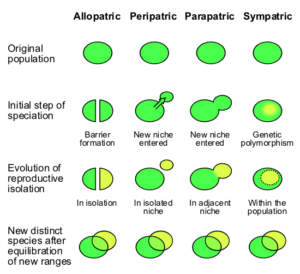Speciation
Speciation is the evolutionary process by which new biological species arise. This process is central to biodiversity and evolutionary theory. Speciation typically involves genetic, ecological, and behavioral changes that lead to reproductive isolation and divergence between populations. The processes of anagenesis and cladogenesis represent two different patterns of evolutionary change, each with unique implications for biodiversity. Through various modes of speciation, such as allopatric, sympatric, parapatric, and peripatric, organisms diversify and adapt to their environments, highlighting the dynamic nature of evolutionary change.
Anagenesis, also known as phyletic evolution, occurs when a single lineage evolves over time into a new species without branching. In this process, the original species is replaced by a new one. Anagenesis involves gradual changes in the population over time, driven by factors like natural selection, genetic drift, or mutations. The species evolves as a whole, and the original species no longer exists in its ancestral form. For example, in the fossil record, anagenesis might appear as a continuous series of slightly altered forms leading from an ancestor to a descendant.
Cladogenesis, or branching evolution, occurs when a lineage splits into two or more separate species. This results in increased biodiversity because the original species and new species coexist. Cladogenesis typically begins with some form of reproductive isolation between populations, which can be geographic, ecological, behavioral, or genetic. The isolated populations diverge due to natural selection, genetic drift, or mutations, eventually leading to distinct species. A classic example of cladogenesis is adaptive radiation, where one species diversifies into several distinct species to fill different ecological niches.
Both anagenesis and cladogenesis can occur through different modes of speciation based on the geographic and ecological context of the populations:

Allopatric speciation occurs when populations are geographically isolated, leading to reproductive isolation and divergence. Geographic barriers, such as mountains or rivers, separate populations, which then evolve independently. Over time, genetic changes accumulate, resulting in speciation.
Sympatric speciation occurs when populations diverge into new species within the same geographic area. Reproductive isolation arises due to factors like polyploidy (common in plants), disruptive selection, or behavioral isolation. Over time, distinct species emerge without physical barriers.
Parapatric speciation occurs when populations are adjacent but not fully overlapping, allowing for limited gene flow. Divergence occurs due to different environmental pressures or mating preferences along a gradient, eventually leading to reproductive isolation and speciation.
Peripatric speciation is a form of allopatric speciation where a small, isolated population diverges from a larger ancestral population. The isolated population, often at the periphery of the ancestral range, experiences rapid evolutionary change due to genetic drift or founder effects, leading to speciation.
Anagenesis and cladogenesis differ in how they contribute to biodiversity. Cladogenesis increases biodiversity by creating new branches in the evolutionary tree, while anagenesis does not increase species diversity but represents evolutionary change within a single lineage. Anagenesis involves linear evolution, while cladogenesis involves branching evolution. In anagenesis, the original species transforms into a new species, whereas in cladogenesis, the original species continues to exist alongside the newly formed species
Media Attributions
- modes of speciation © Illmari Karonen is licensed under a CC BY-SA (Attribution ShareAlike) license

